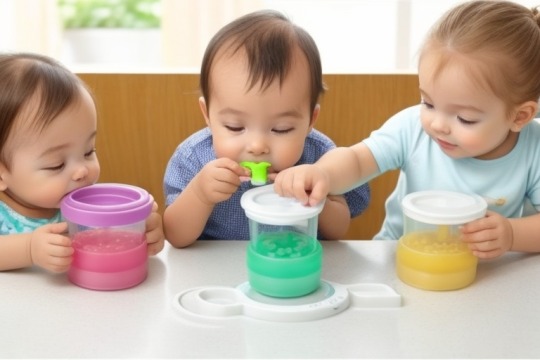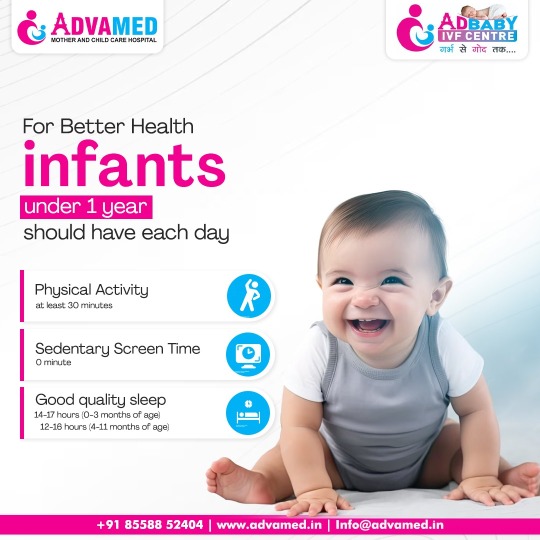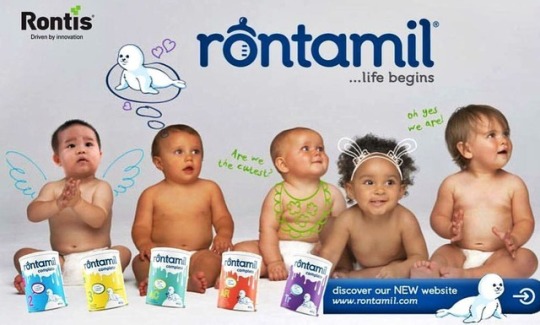#infantnutrition
Text
Breastfeeding: the top 10 tips
Breastfeeding tips
Breastfeeding is a natural and beautiful bond between a mother and her baby. However, it can also be challenging and overwhelming, especially for first-time mothers. As a healthcare professional, it's important to provide new mothers with the proper education and resources to help them successfully breastfeed their newborns.In this blog post, we will discuss the top 10 tips for breastfeeding, from proper latching techniques to overcoming common breastfeeding challenges. Our goal is to alleviate any anxiety or confusion new mothers may have and provide them with the knowledge and confidence to breastfeed comfortably and effectively.We understand that every mother and baby is unique, and what works for one may not work for another. Therefore, we will offer a range of tips and strategies so that new mothers can find what works best for them and their baby.Breastfeeding is not only beneficial for the baby's health, but it also has numerous benefits for the mother, such as reducing the risk of breast cancer and postpartum depression. 1. Find a comfortable position.Finding a comfortable position while breastfeeding is crucial for the mother's comfort and the baby's ability to latch on properly. Before beginning a feeding session, it's important to find a supportive chair or couch with good back support. Many mothers find that using a nursing pillow can be helpful in finding a comfortable position. The pillow can be placed under the baby's head and body to bring the baby up to the level of the breast, which can help reduce strain on the mother's neck and back. Experimenting with different positions, such as the cradle hold or the football hold, can also help find the most comfortable position for both mother and baby. Remember, a comfortable position is key to a successful and enjoyable breastfeeding experience.2. Ensure proper latch technique.When it comes to successful breastfeeding, ensuring proper latch technique is essential. A good latch is important to prevent nipple soreness and damage, and to ensure that your baby is receiving enough milk. To achieve a proper latch, it is important to make sure your baby is positioned correctly and that their mouth is wide open. You should aim to have your baby’s mouth covering as much of the areola as possible, with their lips flanged outwards. You can gently guide your baby’s head towards your breast, but avoid pushing their head onto your breast. Remember to allow your baby to take the lead in finding the right position and angle, and don’t rush the process. With practice and patience, you and your baby will soon develop a comfortable and effective breastfeeding routine.3. Nurse frequently to maintain supply.Nursing frequently is one of the most important tips to maintain a healthy milk supply. The more often you nurse, the more milk your body produces. When you nurse, your body receives signals to create more milk, so nursing frequently will help your body maintain milk production. Aim to nurse at least 8-12 times per day, or whenever your baby shows signs of hunger, such as rooting or sucking on their hands. It's also important to ensure that your baby is latching on correctly to optimize milk transfer and prevent discomfort. Remember, the more you nurse, the more milk you will produce, so make sure to prioritize frequent nursing sessions to maintain your milk supply.4. Avoid pacifiers and bottles.When it comes to breastfeeding, it's important to establish a strong and successful nursing relationship with your baby. One key factor in achieving this is to avoid the use of pacifiers and bottles in the early stages of breastfeeding. This is because the sucking action required for breastfeeding is different from that of a pacifier or bottle, and introducing these items too soon can cause confusion for your baby and potentially lead to nipple confusion or an aversion to breastfeeding. It's recommended to exclusively breastfeed for the first six months of your baby's life, and avoiding pacifiers and bottles during this time can help ensure a successful and fulfilling nursing experience for both you and your baby.5. Stay hydrated throughout day.Staying hydrated is a top priority for breastfeeding mothers, as it helps to maintain an adequate milk supply. It is important to drink enough fluids throughout the day to keep your body hydrated. Experts recommend drinking at least 8-10 glasses of water per day, and even more if you are active or if the weather is hot. You can also include other fluids such as milk, fruit juice, or coconut water to keep yourself hydrated. If you find it difficult to keep track of your water intake, try carrying a water bottle with you at all times and take sips throughout the day. Staying hydrated is one of the most crucial tips for breastfeeding mothers to ensure their milk supply stays consistent and their bodies remain healthy.6. Use nipple cream for discomfort.Breastfeeding can be a rewarding and bonding experience between a mother and her baby, but it can also come with some discomfort. One tip to alleviate soreness and chafing is to use nipple cream. Nipple cream is a lanolin-based ointment that is safe for both mom and baby. It helps to soothe and protect the nipples from dryness, cracking, and irritation during breastfeeding. Using nipple cream regularly can also help to prevent nipple trauma and reduce the risk of infection. It is important to choose a high-quality product that does not contain any harmful ingredients, and to apply it after each feeding and as needed throughout the day. Nipple cream is a simple but effective solution to make breastfeeding a more comfortable experience for both mom and baby.7. Wear supportive nursing bras.Wearing supportive nursing bras is an essential tip for breastfeeding mothers. Not only do nursing bras provide easy access for your baby to breastfeed, but they also offer the support and comfort that your breasts need during this time. Look for bras with wide shoulder straps and adjustable back closures that can accommodate changes in your breast size, which is common during breastfeeding. Avoid underwire bras as they can cause discomfort and potentially lead to blocked milk ducts. It is recommended to invest in at least three to four nursing bras to ensure that you always have a clean and comfortable bra ready to use. With proper support and comfort, a nursing bra can make your breastfeeding journey more comfortable and convenient.8. Seek help if struggling.Breastfeeding can be a challenging experience for many new mothers, especially in the early stages. It's important to remember that seeking help is a sign of strength, not weakness. If you're struggling with breastfeeding, don't hesitate to reach out for assistance from a lactation consultant, your healthcare provider, or a support group. These professionals can provide guidance on proper latch and positioning techniques, offer tips for increasing milk supply, and address any concerns or questions you may have. Remember, you don't have to go through the breastfeeding journey alone. Seeking help is an essential step in ensuring a successful and positive breastfeeding experience for both you and your baby.9. Eat a balanced diet.Eating a balanced diet is essential for maintaining good health, especially for breastfeeding mothers. It is important to consume a variety of foods from all food groups to provide the necessary nutrients for both the mother and baby. A balanced diet should include fruits, vegetables, protein, whole grains, and healthy fats. It is recommended that breastfeeding mothers consume an additional 500 calories per day to support milk production. Including foods rich in calcium, iron, and vitamin D can also be beneficial for both the mother and baby. It is important to consult with a healthcare provider or a registered dietitian for personalized dietary recommendations to ensure optimal health and nutrition during breastfeeding.10. Take care of yourself too.Breastfeeding is a wonderful experience for both you and your baby, but it can also be demanding and exhausting. It's important to remember that taking care of yourself is just as crucial as taking care of your baby. This means getting enough rest, eating a healthy and balanced diet, and staying hydrated. Breastfeeding can burn up to 500 calories a day, so it's important to replenish your body with nutritious foods and plenty of water. Don't forget to take breaks and allow yourself some alone time to relax and recharge. Remember, taking care of yourself will not only benefit you, but also your baby who will thrive on a healthy and happy mother. So, make sure to prioritize self-care and seek support from your partner, family, or healthcare provider if needed.In conclusion, breastfeeding can be a challenging and rewarding experience for both mother and baby. Following these top 10 tips can help overcome common difficulties and provide a successful breastfeeding journey. However, it's important to remember that every mother and baby is unique, and seeking support from a lactation consultant or healthcare provider can be beneficial in addressing individual concerns and needs. By prioritizing self-care, seeking help when needed, and staying committed to the breastfeeding process, mothers can provide their babies with the many health benefits of breast milk while also strengthening the bond between mother and child.

Read the full article
#baby#bonding#breastfeeding#breastfeedingbenefits#breastfeedingchallenges#breastfeedingtechniques#infantnutrition#lactation#latch#maternalhealth#milksupply#motherhood#newborn#nursing#tips
2 notes
·
View notes
Text
Nutricia Neocate LCP, a specially formulated hypoallergenic baby nutritional powder, provides rapid relief from cow’s milk allergy symptoms and supports the baby's healthy growth and development. Neocate LCP powder is ideal for babies who are allergic to cow’s milk. It is ideal for infants from birth to 12 months of age.
#online#nutricia#neocate#LCP#Powder#NeocateLCP#HypoallergenicFormula#InfantNutrition#SpecializedFormula#AllergyFriendly#FoodAllergySupport#NutritionalSupport#GIHealth#PediatricNutrition#GutHealth#InfantFormula#DairyFree#SoyFree#MedicalNutrition#GastrointestinalSupport#HealthcareProfessional#InfantHealth#AllergyManagement#NutritionalTherapy#NeonatalCare#milk
0 notes
Text
Understanding the Triple Feeding Method for Newborns: A Complete Guide
Introduction
To the Triple Feeding Baby Method
The early days of parenting can be both magical and challenging, especially when it comes to feeding your newborn. One method that has gained popularity among new parents is triple feeding. In this article, we will explore what triple feeding is, the reasons why it may be implemented, and the indications that suggest its need.
Definition of Triple…

View On WordPress
0 notes
Text
Infant nutrition | Infant nutrition 4 months | Tips for the infant
#baby_mother#babymother#advice_for_infant#adviceonfeedinginfant#advice_on_feeding_infant#adviceonfeedinginfant4months#advice_on_feeding_infant_4months#baby#4monthinfant#4month_infant#infantnutrition#infant_nutrition#feeding4monthinfant#feeding_4month_infant#tips#recommendations#feedingadviceforbabies4months#feeding_advice_for_babies_4months
0 notes
Link
🥛🚫 Breastfeeding moms who are lactose intolerant or have babies with milk allergies may need to follow a dairy-free diet. But going dairy-free doesn't mean sacrificing nutrition. In fact, it can offer some surprising benefits. 🍎🥦 A dairy-free diet can help breastfeeding moms avoid digestive issues and discomfort. It can also reduce the risk of colic and eczema in babies. But it's important to make sure you're getting enough calcium, vitamin D, and other nutrients. 🍼💪 Here are some tips for a healthy dairy-free breastfeeding diet: focus on nutrient-dense foods like leafy greens, nuts, and seeds; consider taking supplements; and talk to a healthcare provider if you have concerns about your baby's nutrition.1. Understanding the Benefits of a Dairy-Free Breastfeeding Diet🥛🤱🚫 🌱 A dairy-free breastfeeding diet can benefit both the mother and the baby. 👶 Reduces the risk of colic, eczema, and other allergic reactions in babies. 👩👧👦 Improves the mother's digestion and reduces the risk of breast infections. 🌿 Encourages a varied and balanced diet, reducing the risk of nutrient deficiencies. 🍎 It's important to replace dairy with other sources of calcium, such as leafy greens, tofu, and fortified plant-based milk. 🍪 Avoiding dairy can be challenging, but there are many delicious alternatives available, such as nut-based cheeses and ice creams. 🥦 A dairy-free diet can also encourage the consumption of more vegetables, fruits, and whole grains, leading to a healthier lifestyle. 2. Nutritional Considerations for a Dairy-Free Breastfeeding DietWhen breastfeeding, it's important to maintain a healthy diet, especially if you're avoiding dairy. Here are some nutritional considerations: Calcium is essential for bone health. Get it from leafy greens, fortified non-dairy milk, and supplements. Vitamin D helps your body absorb calcium. Get it from sunlight, supplements, and fortified non-dairy milk. Protein is important for muscle and tissue growth. Get it from beans, nuts, seeds, and non-dairy milk. Iron is important for energy and brain function. Get it from leafy greens, beans, and fortified non-dairy milk. Omega-3 fatty acids are important for brain and eye development. Get it from flaxseeds, chia seeds, and algae-based supplements. It's also important to stay hydrated and consume enough calories to support milk production. Consult with a registered dietitian for personalized recommendations. Remember, a dairy-free diet can still be delicious and satisfying! Try new recipes and experiment with different ingredients. 🍴3. Tips for Successfully Implementing a Dairy-Free Breastfeeding DietImplementing a dairy-free breastfeeding diet can be challenging, but it's possible. Here are some tips to make the transition easier: Read food labels carefully, as dairy can be hidden in many products. Find dairy-free alternatives for your favorite foods, such as almond milk instead of cow's milk. Plan your meals and snacks ahead of time to ensure you have enough variety and nutrients. Consider consulting with a registered dietitian to ensure you're meeting your nutritional needs. Stay hydrated and eat plenty of fruits and vegetables for optimal health. Remember that a dairy-free diet can be healthy and delicious. Don't be afraid to experiment with new recipes and ingredients. Be patient with yourself and your body as you adjust to the new diet. It may take some time for your taste buds and digestive system to adapt. Don't hesitate to reach out to other breastfeeding moms who have successfully implemented a dairy-free diet. Their support and advice can be invaluable. Finally, don't forget to celebrate your successes along the way! 🎉4. Common Challenges of a Dairy-Free Breastfeeding Diet and How to Overcome ThemWhen following a dairy-free breastfeeding diet, there are some common challenges that moms may face. Here are some tips to overcome them: Limited food options: Look for dairy-free alternatives and experiment with new recipes. 🍴 Nutrient deficiencies: Consult with a healthcare provider and consider taking supplements. 💊 Lack of support: Connect with other dairy-free moms and seek advice from lactation consultants. 🤝 Increased meal prep: Plan ahead and batch cook meals to save time. 🍲 Hidden dairy: Read labels carefully and ask for ingredient lists when eating out. 🔍 Cravings: Find dairy-free alternatives to satisfy cravings and practice self-control. 🍫 Expense: Shop for dairy-free products on sale and buy in bulk. 💰 Remember, a dairy-free breastfeeding diet can be challenging, but it's worth it for the health of your baby. Stay positive and don't hesitate to ask for help. 👍5. Recipes and Meal Ideas for a Dairy-Free Breastfeeding Diet🍴 Looking for delicious meal ideas while breastfeeding on a dairy-free diet? We've got you covered! Here are some tasty recipes to try: 🥗 Salad with grilled chicken, avocado, and roasted sweet potatoes. Dress with olive oil and balsamic vinegar. 🍲 Creamy tomato soup made with coconut milk instead of cream. Serve with gluten-free crackers. 🍝 Spaghetti squash with meat sauce made with ground turkey and tomato sauce. Top with nutritional yeast instead of parmesan cheese. 🍛 Curry made with chickpeas, spinach, and coconut milk. Serve with brown rice. 🥪 Turkey and avocado sandwich on gluten-free bread with hummus instead of cheese. 🍨 For dessert, try dairy-free ice cream made with coconut milk or almond milk. 🥛 Don't forget to include calcium-rich foods like leafy greens, almonds, and fortified non-dairy milk in your diet. Happy eating!6. The Role of Supplements in a Dairy-Free Breastfeeding DietSupplements can help maintain a healthy milk supply for breastfeeding moms who are dairy-free. Fenugreek: Helps increase milk production. Brewer's yeast: Rich in B vitamins and iron. Calcium: Important for bone health. Omega-3 supplements like fish oil can also benefit both mom and baby's brain development. Probiotics can help improve digestion and reduce colic in infants. Look for dairy-free options. Vitamin D is essential for bone health and immunity. Consider a supplement if you're not getting enough sun exposure. Consult with a healthcare provider before taking any supplements, especially if you have underlying health conditions. 👍👶🍼7. Frequently Asked Questions About a Dairy-Free Breastfeeding Diet Q: Why do I need to go dairy-free while breastfeeding? 🤱🏻Dairy can cause digestive problems in babies. 🥛Milk proteins can pass through breastmilk. 🧪Lactose intolerance can develop in infants. Q: What foods should I avoid? 🍦Ice cream, cheese, and yogurt. 🍪Baked goods with milk or butter. 🍔Processed foods with milk ingredients. Q: How can I ensure I'm getting enough calcium? 🥦Eat calcium-rich foods like broccoli and kale. 🌰Include nuts and seeds in your diet. 🌿Consider taking a calcium supplement. Q: Can I still breastfeed if I accidentally consume dairy? 🤱🏻It depends on your baby's sensitivity. 🥛Small amounts may not cause a reaction. 🧪Talk to your doctor if you're unsure. Q: Will a dairy-free diet affect my milk supply? 🤱🏻No, as long as you're getting enough nutrients. 🥛Dairy isn't necessary for milk production. 🍼Stay hydrated and eat a balanced diet. Q: How long do I need to be dairy-free? 🤱🏻It depends on your baby's sensitivity. 🥛Some babies outgrow their sensitivity. 🧪Talk to your doctor before reintroducing dairy. In conclusion, a dairy-free breastfeeding diet can benefit both mother and baby. It can reduce colic and other digestive issues in infants, while also improving maternal health. Remember to consult with a healthcare professional before making any dietary changes. Some tips for a successful dairy-free breastfeeding diet include reading labels carefully, finding alternative sources of calcium and vitamin D, and experimenting with new recipes. Don't be afraid to ask for support from family and friends, and remember that every mother's breastfeeding journey is unique. 🥛🚫💪🏼 With proper planning and support, a dairy-free breastfeeding diet can be a healthy and rewarding choice for both mother and baby. https://fastdiet.net/dairy-free-breastfeeding-diet-benefits-and-tips/?_unique_id=6493eca4a3c27
#Uncategorised#dairyfreebreastfeeding#healthyfats#infantnutrition#lactoseintolerance#plantbaseddiet#aiomatic_0
0 notes
Text
best child specialist Hospital in Chandigarh
Nourishing little ones for a bright tomorrow! 🌟 Discover the essential nutrients infants under 1 year need daily for healthy growth and development.
👉 Adbaby IVF Centre Advamed Hospital
Contact Us 📞 : +91- 85588 52401/ 8558852404
Our Location ✅ :- Chandigarh Ambala Highway, Zirakpur, Punjab - 140603
:

InfantNutrition #HealthyStarts #growingstrong
0 notes
Text
New Study Shows Neonatal Diet Can Affect Long-Term Cognitive Outcome in Preterm Infants
New Study Shows Neonatal Diet Can Affect Long-Term Cognitive Outcome in Preterm Infants. #prematurebabies #neonatalhealth #breastfeeding #infantnutrition #cognitiveoutcomes #NEC #infectionprevention #longtermhealth #pediatricresearch
Neonatal Diet- A recent study has demonstrated the significant effect that neonatal diet can have on preterm infants’ long-term cognitive development. Breast milk has long been linked to lower risks of infection and necrotising enterocolitis (NEC) among preterm babies; however, when left unsupplemented it does not meet all their nutritional requirements.
Photo by Jill Wellington on Pexels.com
A…

View On WordPress
0 notes
Photo

Today my little #moonpie did a thing! She has been hinting at being ready for more than just #breastmilk so following her lead we began our research for the best possible product for her. I plan to make our own food but finding an instant option was also important. We settled on @happyfamilyorganics Quinoa and Oats for her first meal and it was a hit! She loved the taste and we loved the ease. A scoop of the instant oatmeal and a little breastmilk and our little honey was in heaven! Thanks @happyfamilyorganics for being a safe product my family could trust! #babyledweaning #organicbabyfood #healthyfood #infantnutrition #firsttimemom #mommyblogger #motherhood #firstbaby #infantino #babygirl #babiesofinstagram #happybaby (at South Euclid, Ohio) https://www.instagram.com/p/CaNPns8O8lY/?utm_medium=tumblr
#moonpie#breastmilk#babyledweaning#organicbabyfood#healthyfood#infantnutrition#firsttimemom#mommyblogger#motherhood#firstbaby#infantino#babygirl#babiesofinstagram#happybaby
0 notes
Link
Food is the primary source providing the human body with vital nutrients required for healthy functioning. Similarly, infants require food for their healthy growth and development, which is mostly obtained from breast milk. Infant nutrition is a substitute food for breast milk.
0 notes
Text
Good News: March 2019
This world is chock-full of bad news. We get that. As people of faith, we look for Good News wherever we can. This is what we’ve found...

More Syrian Kids Back in Class
The schools in Syria are being rebuilt so rapidly we can barely keep up. Bless God. Our staff on the ground interviewed Ahmed, a 13-year-old who attends the new school. Here is what he has to say about his new school:
We thank the teachers and teachers that they prepared for us the school and my joy is indescribable and thank each one participated in preparing the school ... I love the lesson of Arabic, playing football with my friends and I hope to become a veterinarian.”

Let The Growing Begin
Last month our team in Bangladesh distributed 50 infant nutrition packs, 50 mosquito nets and 250 food packs to Rohingya refugees who continue to have limited access to basic necessities. That means 50 future leaders, 50 less cases of malaria, and 250 families who are eating well tonight because of you.

From Refugees to Sewing Trainers
Gee Sam and Korn Sant are from Kachin State and have been training in sewing over the past 4 months. They went from not knowing how to sew at all to making their own dresses and bags.
Partners provided the opportunity and funds for them to learn to sew and then equipped them with fabric, materials and sewing machines to take to Kachin State to begin a sewing project where they will train others from the IDP camps.
Gee Sam shares, “It has been very good for me to learn how to sew. I am very happy to go back and train people in the Kachin IDP Camp. Thank you, Partners, for this opportunity.”
This is how women thrive - and not merely survive - in less-than-ideal circumstances, and we are proud of them.

A Sustainable Future for Shan Schools.
One of our staff members has just returned from more than a month in Shan State to monitor and evaluate our Sustainable Schools program. The good news? 13 new community-owned projects (that have their profits fund education in their community) were initiated in 2018! That brings the current total to 78 communities now having greater capacity to keep their kids in school. We love seeing communities empowered to overcome the problems they face and we’re thankful you’re partnering with them to provide the seed capital that makes these sustainable projects a reality.

Good Food for the Hungry
in late February, our team packed 1,000 boxes of food and distributed them to hungry families who are now not hungry at all. 5000 people ate who had no food the day before. Babies wore clean diapers for the first time in a while. Parents sipped tea while their kids sleep soundly because they knew there would be more where that came from.
Friends, every bit of this is good news. Every bit is Gospel work, love in action, wrongs being righted. Thank you for being with us and for sending us. We couldn’t do this without you; we couldn’t love and we couldn’t act if you didn’t love and act first.
#goodnews#rohingya#syria#myanmar#shan#bangladesh#relief#development#education#sustainableschools#infantnutrition
0 notes
Text
Breastfeeding: how to pump only
Breastfeeding: exclusive pumping
Breastfeeding is a natural experience that provides numerous benefits to both the mother and the baby. However, not all mothers are able to breastfeed their newborns due to various reasons such as medical conditions, work commitments, or personal preferences. In such cases, pumping breast milk is a viable option that allows the baby to receive the same nutritional benefits as direct breastfeeding.Pumping breast milk can be a daunting task, especially for new mothers who are still learning how to navigate their way through motherhood.It requires a certain level of commitment, dedication, and knowledge to ensure that the baby receives the necessary nutrients and the mother maintains a good milk supply.In this blog post, we will provide you with tips and tricks on how to exclusively pump breast milk for your baby.We will cover topics such as the benefits of pumping, how to establish a pumping routine, how to maintain a good milk supply, how to store and handle breast milk, and much more.Our aim is to equip you with the necessary information and resources to make the breastfeeding journey as smooth and stress-free as possible. So, whether you are a new mom or a seasoned pro, this blog post is for you.1. Choose the right breast pump.When it comes to breastfeeding, choosing the right breast pump is crucial for a successful and efficient pumping experience. With so many options available on the market, it can be overwhelming and confusing to know which one is best for you. However, there are a few key factors to consider when making this decision. First, determine whether you need a manual or electric pump. Manual pumps are typically less expensive and more portable, but require more effort and may not be as efficient as an electric pump. Next, consider the suction strength and speed settings of the pump. This can vary between different models, so it's important to choose one that is comfortable and effective for you. Additionally, think about the size and weight of the pump, as well as any additional features such as a rechargeable battery or a hands-free option. By carefully considering these factors and doing research on different brands and models, you can find the perfect breast pump that meets your needs and helps you successfully pump breast milk.2. Get your pumping routine.To successfully maintain a breastfeeding routine, it is important to establish a consistent pumping schedule. This not only helps to maintain your milk supply, but also ensures that you have enough breast milk stored for times when you may not be able to nurse directly. It is recommended to pump at least 8-10 times a day, with breaks of no longer than 3-4 hours in between sessions. This will help to keep your breasts stimulated and prevent engorgement. It is also important to pump for a minimum of 15 minutes each session to fully empty the breasts. You can also try to pump at the same time each day to establish a routine and maintain a healthy milk supply. Remember, establishing a consistent pumping routine is key to successful breastfeeding.3. Mimic natural breastfeeding patterns.When it comes to pumping breast milk, it's important to mimic the natural breastfeeding patterns as closely as possible. This means pumping regularly, about every 2-3 hours during the day and once or twice at night. It's also important to pump for at least 15 minutes per session, as this is the average length of a feeding session for a breastfeeding baby. This will help maintain a steady milk supply and prevent engorgement. Additionally, try to pump in a quiet and comfortable environment, as stress and distractions can affect milk production. It's also helpful to pump on both breasts, as this mimics the natural feeding pattern and can help empty the breasts more effectively. By following these tips, you can successfully mimic natural breastfeeding patterns while exclusively pumping for your baby.4. Store breast milk properly.Properly storing breast milk is crucial for ensuring its safety and nutritional value for your baby. When pumping and storing breast milk, it is important to follow recommended guidelines to prevent contamination and spoilage. Start by washing your hands thoroughly before handling the breast pump, storage containers, and breast milk. Use clean, sterilized bottles or storage bags specifically designed for breast milk. After pumping, immediately store the milk in the refrigerator or freezer. Breast milk can be stored safely in the refrigerator for up to four days, or in the freezer for up to six months. Be sure to label each container with the date and time it was expressed. When thawing frozen breast milk, do not use the microwave as it can destroy important nutrients and create hot spots that can burn your baby. Instead, thaw the milk in the refrigerator and gently swirl or rotate the container to mix the layers of cream and milk. By properly storing your breast milk, you can ensure that your baby is receiving safe, high-quality nutrition.5. Keep your equipment clean.It is essential to maintain clean equipment when exclusively pumping for breastfeeding. This not only ensures the safety and health of your baby but also helps maintain an adequate milk supply. Before and after each pumping session, wash all pump parts that come into contact with breast milk with hot, soapy water. Rinse thoroughly and let air dry or dry with a clean paper towel. It is also recommended to sanitize pump parts once a day by boiling them for 10 minutes or using a steam bag. Additionally, make sure to regularly clean and sanitize the surface where you prepare and store your equipment. By keeping your equipment clean, you are providing the best possible milk for your baby and reducing the risk of contamination.6. Maintain your milk supply.Maintaining your milk supply is essential for successful breastfeeding, especially when exclusively pumping. To ensure a steady and abundant supply of breast milk, it is important to pump regularly, ideally as often as your baby would breastfeed. This can be challenging for busy mothers, but it is crucial for maintaining milk production. Additionally, staying hydrated and eating a well-balanced diet can also help sustain a healthy milk supply. Finally, considering using a high-quality breast pump and practicing proper pumping techniques can also contribute to maintaining your milk supply. By following these tips, you can successfully continue breastfeeding through pumping.7. Stay comfortable while pumping.When it comes to breastfeeding, many new mothers may find themselves needing to pump breast milk for various reasons. However, pumping can often be an uncomfortable and even painful experience. To make the process easier and more comfortable, it is important to invest in the right equipment and take certain measures. One helpful tip is to stay comfortable while pumping. This can be achieved by finding a quiet and private place to pump, using a comfortable and supportive pumping bra, and adjusting the suction strength on the pump to a comfortable level. Additionally, using warm compresses or massaging the breasts before pumping can also help in promoting comfort. By prioritizing comfort while pumping, mothers can make the experience more enjoyable and ultimately increase their milk supply.8. Stay hydrated and nourished.Proper hydration and nutrition are essential for maintaining a healthy milk supply while exclusively pumping. As a breastfeeding mother, it is important to stay hydrated by drinking plenty of water throughout the day. Aim to drink at least 8-10 glasses of water daily and keep a water bottle nearby to remind yourself to stay hydrated. Additionally, nourishing your body with a balanced and nutritious diet can greatly impact your milk production. Focus on consuming foods high in protein, healthy fats, and complex carbohydrates to provide your body with the necessary nutrients to produce quality breast milk. Incorporating foods such as lean meats, whole grains, fruits, and vegetables into your diet can help support your breastfeeding journey.9. Pump while traveling.When it comes to breastfeeding, there are many challenges that new mothers face, including the need to pump while traveling. Whether for work or personal reasons, being away from your baby for an extended period of time can be stressful and make it difficult to maintain your milk supply. However, with the right planning and preparation, it is possible to continue breastfeeding and pumping while on the go. In this guide, we will discuss the essential tips and tricks for pumping while traveling, ensuring that your breastfeeding journey remains as smooth and successful as possible.10. Seek support and guidance.Breastfeeding can be a challenging and overwhelming experience, especially when it comes to exclusively pumping. It's important to seek support and guidance from lactation consultants, healthcare providers, and other experienced mothers. These professionals can provide valuable tips and advice on how to effectively pump and maintain milk supply. They can also offer emotional support and encouragement during this journey. Additionally, joining online or in-person support groups for exclusively pumping mothers can provide a sense of community and helpful advice from others going through a similar experience. Remember, you are not alone and there are resources available to help you succeed in exclusively pumping.In conclusion, pumping can be a great option for mothers who want to provide breast milk for their babies but are unable to breastfeed directly. However, it's important to approach pumping with a professional and informed mindset. By following best practices for cleaning and storing breast pump equipment, creating a pumping schedule that works for you, and maintaining a healthy diet and hydration level, you can ensure that your baby receives the best possible nutrition. With dedication and perseverance, you can successfully provide your baby with the benefits of breast milk through pumping alone.

Read the full article
#baby#bonding#breastfeeding#breastfeedingbenefits#breastfeedingchallenges#breastfeedingtechniques#infantnutrition#lactation#latch#maternalhealth#milksupply#motherhood#newborn#nursing#tips
1 note
·
View note
Photo

📌Fore milk v/s Hind milk 🔹Transition from fore milk to hind milk is gradual. So it is important to empty each and every session. Babies need a balance of both for proper growth and development. . . 🔻Do tell us about your views in the comment section😀👇🏻 ___________________________________ 📩DM for any sought of queries ___________________________________ Follow us on Facebook :- dietitiangarima ___________________________________ 👻Snap us at Snapchat :- garimagoyal_15 ___________________________________ 📞For Appointments :- 9888055988 ___________________________________ . . #dietitian #dietplans #nutritionist #health #Creatinghealthylives #healthymeals #registereddietitian #rd2be #rd #worldbreastfeedingweek2018 #BreastfeedingAwarenessMonth #BreastfeedingUncovered #breastfeedingweek #weaningfoods #breastfeedingatoddler #infantnutrition #foremilk #hindmilk #hindmilkdoesababygood #hindmilkvsforemilk #breastmilk #Breastisbest #fooducate #foodporn #dietitiangarima (at Ludhiana, Punjab, India)
#dietitian#dietplans#nutritionist#health#creatinghealthylives#healthymeals#registereddietitian#rd2be#rd#worldbreastfeedingweek2018#breastfeedingawarenessmonth#breastfeedinguncovered#breastfeedingweek#weaningfoods#breastfeedingatoddler#infantnutrition#foremilk#hindmilk#hindmilkdoesababygood#hindmilkvsforemilk#breastmilk#breastisbest#fooducate#foodporn#dietitiangarima
0 notes
Photo

From infant to welderly - health for all. We provide services across the lifespan from noninvasive infant formula food testing to memory health services. Call us to learn more #infantnutrition #nutritiontesting #brainhealth #wholehealth #memoryhealth #memorytesting #SteppingStoneClinicMN #stumblingblockstosteppingstones
#memorytesting#nutritiontesting#wholehealth#memoryhealth#infantnutrition#stumblingblockstosteppingstones#steppingstoneclinicmn#brainhealth
0 notes
Photo

Check out our new and improved dedicated Infant Nutrition Website!! Find all the information about babies nutrition as well as super-useful tips on parenthood as explained by Dr. Millie the Seal 😉! #rontamil #infantnutrition #babynutrition #babymilk #completenutrition #millietheseal #drmillie #rontis #drivenbyinnovation
#drmillie#drivenbyinnovation#rontis#babynutrition#rontamil#babymilk#completenutrition#infantnutrition#millietheseal
0 notes
Link
Get more details @ http://bit.ly/2qxiav5
Infant Nutrition Market Size, Industry Analysis Report, Regional Outlook (U.S., Canada, Germany, UK, France, Italy, Russia, China, India, Japan, Malaysia, Thailand, Indonesia, Australia, Brazil, Saudi Arabia, UAE, South Africa), Application Growth Potential, Competitive Market Growth & Forecast, 2017 – 2024
#InfantNutritionMarketSize#GlobalBabyFood#GlobalInfantFormulaMarket#InfantNutritionMarketShare#InfantNutritionMarketTrends#Nutrition#InfantNutrition#BabyFoods#InfantMilkFormula
0 notes
Photo

jOURney-2-Eating-Right is now an LLC. Accepting only pay by cash appointments but working towards expanding this so as to be an in-network provider with insurances, prices are reasonable. Inbox me for questions or to set up an appointment. #journey2eatingright #eatbetter #weightloss #breastfeeding #IBCLC #infantnutrition #nutritionexpert #dietitianapproved #Dietitian #privatepractice #nutrition #healthyeating #healthylifestyle #healthprofessional #gethealthy
#healthylifestyle#ibclc#nutritionexpert#dietitianapproved#journey2eatingright#infantnutrition#dietitian#breastfeeding#gethealthy#nutrition#privatepractice#weightloss#healthyeating#healthprofessional#eatbetter
0 notes